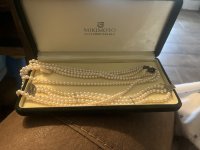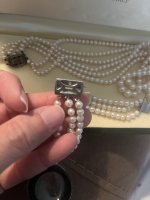Welcome to Pearl Guide!
I'm truly sorry to read of your mother's need to sell. I'm sure these are sentimental items. What I have to say may cause her to decide to keep them, but if she still decides to sell, this may lend some insight.
The plain fact is that used (pre-owned) pearls just don't tend to hold their value. As we often tell people, the exceptions are Mikimoto specifically (or historic pearls), but even so they often don't bring as much money as one might wish. You can search on eBay for SOLD similar items to get an idea of what they may sell for.
The following may affect the value on resale:
• Lack of documentation could be an issue to some people, but the fact that you have the box, and that the tarnished clasp is obviously not new/counterfeit, and the pearls have not been restrung will go far to assure buyers the necklace is actually real Mikimoto. (There are fake Miki clasps, and sometimes real Miki clasps are strung onto unbranded pearls to sell for a higher price. One can sometimes find Miki clasps being sold on eBay and I imagine some of these are purchased for just such a purpose.)
• The fact that the clasp is tarnished and the pearls need restringing will be off-putting to anyone who doesn't want to have to pay to restring them. Restringing can be expensive-- some years ago I was quoted $78 by a local jeweler to restring a single strand 18" necklace; a triple strand could easily run several hundred dollars at a regular jeweler.
A buyer will mentally deduct what it would cost them to have these restrung from what they would be willing to pay for them. Result: a lower selling price.
Some people send their pearls to Mikimoto to be authenticated and restrung. Mikimoto charges a lot of money to do that. Someone who got a quote for that posted that authentication costs around $250 plus shipping. Another poster said she was quoted $160 plus $38 shipping to restring a single strand 18" necklace, and $400 for an appraisal.
The tarnish would have to be removed from the clasp; I don't know if Mikimoto would do that. Buying a new clasp would be very expensive (I think they are all 18K gold nowadays.) Whatever you'd have to pay for authenticating and paying to restring them would come off the final money you make from selling them. I wouldn't do it-- not to resell them.
Generally speaking I urge people to restring their own pearls-- I wrote a tutorial on how to do it, which is a sticky in our Lowly Beaders Club section.
However, I don't think it would be a good idea for you to restring vintage Mikimoto pearls just to sell them. As I said, the fact they look as they do is what makes them look authentic. But if your mom decides to keep them, then it would be worthwhile to restring them yourselves.
• The fashion nowadays is for straight size strands (e.g. 7.5-8.0mm, or 7.0-7.5mm), not graduated ones.
Also more people will tend to want a single strand necklace than a triple strand one.
That being said, all it takes is one buyer who likes the old fashioned graduated style or who loves triple strands.
• One good thing is that the pearls do not seem to have yellowed with age, as many pearls do.
About the bracelet:
They definitely look like akoyas to me, not imitation pearls.
I can't make out any metal mark on the clasp. Check with a magnifier or better yet, a 10x loupe if you have one. If you don't you can take the bracelet to a jeweler and ask to look at the clasp with their loupe. Maybe it's 14K white gold. If so it ought to be marked 585 or 14K.
I would not assume the bracelet is Mikimoto without a Mikimoto mark on the metal. But you can still sell it. People do buy pearl bracelets. In fact it may be easier to sell the bracelet than the necklace. I see a bit of grime on the pearls; you'll want to wipe them clean with a damp soft cloth before photographing for sale.
Where to sell:
I sometimes suggest to people to consign their pearls with a local jeweler, but I think you may have a hard time doing that with the necklace, given the fact that they are not in a ready-to-wear condition. Maybe the bracelet could be consigned. But the shop would take 50% of the selling price typically. In any case selling via consignment is a slow process. It sounds like your mother wants to sell them faster than that.
You might want to check out Loupe Troop as selling venue.
Likely eBay offers the widest possible audience and quickest sale. If you go this route, check for what similar items (in similar condition) sold for recently. If whatever that amount it sold for would satisfy you, then either set up an auction with the starting price the least you would accept for them, and let the market decide the final selling price, or list them at a Buy It Now price that is realistic, and you could also let people Make An Offer.
I hope this helps.
An afterthought: With gold being so high priced, she will probably make money more quickly selling old gold she no longer wants.







